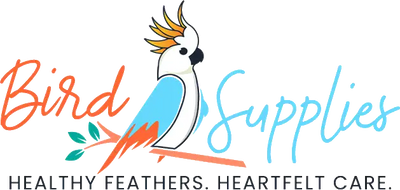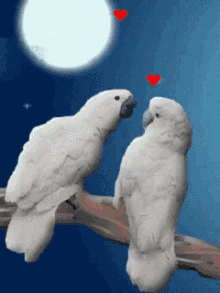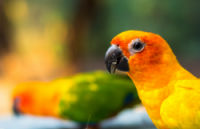- Is Bird Separation Anxiety Real?
- What Causes Separation Anxiety in Birds?
- How Do I Know If My Bird Has Separation Anxiety?
- How Can I Help My Bird With Separation Anxiety?
- What Can I Give My Bird for Anxiety?
Your bird seems fine—until you grab your keys or head toward the door. Suddenly, the screaming starts. Or the pacing. Or maybe you come home to a mess of feathers and shredded cage bars. If your parrot turns into a feathered mess the moment you leave, you’re not alone. Many bird parents struggle with what looks like clinginess—but is actually something deeper: separation anxiety.
Just like dogs or kids, parrots can get deeply attached to their humans. And when they don’t know how to cope with alone time, their stress shows up in ways that are easy to miss—or hard to manage. In this post, you’ll learn the top signs of separation anxiety in birds, what causes it, and most importantly, how to help your bird feel safe and calm, even when you’re not around. Let’s get into it.
Is Bird Separation Anxiety Real??
Bird separation anxiety is when your pet experiences physiological reactions to being alone or separated from their caretaker. We hear about it in dogs all the time. But, pet birds are prone to separation anxiety, too.
After all, birds are our flock animals. In other words most of our pets live in massive flocks in the wilderness. Their whole psyche is geared toward “being together.” In the wild, one sole bird is likely to become a predator's lunch. There is safety in numbers.
There are other theories about why birds get separation anxiety, which I'll get into a little deeper.
What Causes Separation Anxiety In Birds?
Hand Feeding:
Puppies and kittens get to stay with their moms and littermates for weeks. During that time, they learn how to play, socialize, and feel safe. But many baby parrots? They're pulled from the nest before they even grow feathers—all so they’ll bond more easily with humans.
It might sound harmless, but early separation from parents like this can be traumatic. These chicks miss out on critical life lessons from their parents—how to feel secure, how to interact, and how to self-soothe. Research shows hand-fed birds are more likely to develop anxiety, fearfulness, and even behavioral issues like feather plucking later on (Schmid, Doherr, & Steiger, 2006, University of Bern).
If you’re thinking of bringing a bird into your life, ask the breeder about their handfeeding philosophy. Ethical breeders allow chicks to stay with their parents, at least part-time, so they grow up emotionally strong. Let’s support breeders who put bird well-being first—not those who treat them like products.
Early Bonding
Sometimes, we accidentally create clingy, anxious birds without even realizing it. It usually starts with love—constant cuddles, shoulder time, and being together 24/7. But without meaning to, we reinforce a tight emotional bond instead of teaching real-life bird skills. The result? A parrot who panics the second you’re out of sight.
Parrots need guidance, not just affection. Just like a toddler, they thrive when we teach them how to explore, solve problems, and entertain themselves. Training should focus on building confidence, not dependence. As Dr. Susan Friedman explains, “Behavior is a tool to get needs met”—and when birds don’t learn how to meet those needs naturally, anxiety shows up loud and clear.
Ready to raise a more independent, well-adjusted bird? Check out my popular post: How to Encourage Natural Parrot Behaviors in Captivity . It’s full of simple ideas to shift from “best friend” to confident parront—and help your bird feel safe, curious, and capable.
Raising Birds Not Babies
We read books on dog training. We research parenting techniques. But with parrots—some of the smartest, most emotionally tuned-in pets out there—we’re often handed a bird and told to just “bond.” These birds are still very instinctual, with wild behaviors hardwired in. They’re flock animals with big brains, strong opinions, and deeply social needs. That’s why a happy, well-adjusted parrot doesn’t just need love—they need a learning plan.
It’s totally natural to want a snuggly sidekick. And sure, some birds enjoy close contact. But parrots build real trust through interaction and skill-building—not by being glued to your shoulder all day. That’s where parronting comes in. It’s about teaching your bird how to forage, play on their own, try new things, and feel calm even when you're not around. Positive reinforcement makes all of this easier. It helps your bird feel safe, seen, and empowered—without creating clinginess.
The best parrot-human relationships grow from mutual trust and understanding. That’s something you can build, starting right now. You don’t need fancy equipment or tons of experience—just curiosity, consistency, and a willingness to guide. Try teaching a simple target behavior, offering safe new textures to explore, or hiding treats for a mini foraging game. These small steps lay the foundation for a confident bird who feels secure in their world—and in their bond with you.
Lack of Enrichment and Skill-Building
Parrots are built to move, explore, and connect. In the wild, they fly miles a day, forage for food, and stay close to their flock. But here's something we don’t always think about—their parents and flockmates spend months teaching them how to do these things. How to stay safe. How to groom, forage, play, and pitch in. These natural skills help them bond and stay independent—so the flock can function as a team.
At home, you’re not just your bird’s best friend—you’re their parront. That means it’s up to you to teach those same life skills. How to explore. How to play. How to forage for food and groom without stress. Without this kind of guidance, your bird may grow overly attached and unsure of how to manage on their own.
The good news? Enrichment works. Even small changes—like offering puzzle toys, shreddable materials, and sensory activities—can make a huge difference. Want ideas to get started? Check out this post: Easy Bird Enrichment Ideas to Keep Your Parrot Busy and Happy .
Poor Nutrition Can Fuel Anxiety
Just like us, birds need balanced nutrition to feel their best—physically and emotionally. A diet that’s too low in key nutrients like B-vitamins, omega-3’s, calcium, or magnesium can affect brain health and emotional regulation. Birds who aren't getting what they need may be more reactive, anxious, or prone to feather plucking.
That’s why avian vets recommend a foundation of pellets and fresh chop. But even with a great diet, some birds benefit from added support—especially during times of stress, hormonal changes, or feather growth. That’s where gentle, bird-safe nutraceuticals come in.
Want to learn how nutrition affects your bird’s behavior?
👉 Check out this blog on how diet impacts mood and feather health.
How Do I Know If My Bird Has Separation Anxiety?
Birds can’t text you “I miss you,” but trust me—they have their ways. Screaming? Feather plucking? Pacing like they’ve got somewhere to be? These can all be signs your parrot’s not handling alone time too well. Separation anxiety is more common than you think, and it usually starts small—until one day you realize your bird’s having a full-on meltdown every time you leave the room.
Let’s look at five signs that your feathered friend might be struggling—and what you can do to help.
-
Screaming When You Leave the Room
If your bird screams the moment you leave the room and stops when you return, that’s a red flag. Some parrots even start screaming the second they see you getting ready to go. This behavior isn’t about being naughty—it may be a panic response from feeling abandoned.
-
Refusing To Eat
Some birds get so anxious when left alone, they stop eating altogether. In the wild, mealtime = flock time, so eating alone can feel scary. If your bird munches happily when you’re around but ignores their food the minute you leave, that’s a big clue they’re not just lonely—they’re stressed.
Skipping meals isn’t just emotional—it can hurt their health. Try easing the anxiety with foraging toys, calming background sounds, or short practice sessions where you leave and come back. The goal? Teach your bird that alone time is safe... and snack time never stops.
-
Over-preening or Feather Plucking
Some birds start preening nonstop or plucking out their feathers when they’re left alone. What starts as grooming can quickly turn into a stress habit—a way to cope when they feel anxious or unsafe. If your bird looks fine when you're home but starts picking or over-preening when you're gone, it's a strong sign they’re not handling alone time well.
Over time, this behavior can lead to bald spots, irritated skin, and even infections. It’s not about vanity—it’s about comfort. Helping your bird feel more secure when you're away can break the cycle before it becomes a long-term problem.
Photo by Bob G., Used with permission. 2024
-
Repetitive Behaviors
When birds experience separation anxiety, they may develop repetitive behaviors as a way to cope with their stress. These behaviors can include constant pacing, spot-picking (repeatedly picking at a particular spot), or route tracing (following the same path in their cage over and over).
Repetitive behaviors aren't just quirky habits; they're signs that your bird is struggling with being alone. Recognizing these behaviors early is crucial, as they can become ingrained and harder to address over time. Providing environmental enrichment, such as foraging toys and social interaction, can help alleviate the anxiety driving these repetitive actions.
-
Destructive Behavior When You're Gone
When birds are highly anxious—especially from being left alone—they may act out through destructive behaviors. This can look like chewing cage bars until the paint wears off, ripping up toys in a frantic way, or tearing apart anything they can reach, like perches or food bowls. It’s not just boredom—it’s a release of nervous energy.
How Can I Help My Bird With Separation Anxiety?
Good news: you can help your bird feel calmer and more confident when you’re away. With a few small changes and some daily practice, your feathered friend can learn that alone time isn’t scary—it’s just part of the routine. Here’s how to get started:
1. Create a Predictable Routine
Birds thrive on rhythm. Knowing what to expect helps them feel safe. Try to keep wake-up, mealtimes, play, and bedtime around the same time each day. Use a short “I’ll be back” phrase every time you leave the room so they learn that you always return. Over time, this creates trust and security.
2. Gradually Build Alone Time
Don’t go from being glued at the hip to hours apart. Start small. Step out of the room for a minute or two, then slowly increase the time. Always return calmly—no big “mom’s home!” moment. The goal is to make your comings and goings feel no big deal.
3. Make the Cage a Happy Place
Set your bird up for success by making their space fun and interesting. Save favorite toys or treats for times when they’re alone. Switch out toys every few days to keep things fresh, and offer natural perches, swings, or even a safe window view. This turns alone time into enrichment time.
4. Teach Independent Play
Your bird doesn’t need to be on your shoulder all day to feel connected. Parrots do need daily social time—but that doesn’t mean nonstop one-on-one attention. Just being near you, your family, or other pets while doing their own thing—like foraging, playing, preening, or watching TV—can meet that need. Teach your bird to enjoy solo activities by rewarding calm, curious behavior and offering toys that encourage independent play.
|
Hot Tip: Keep tiny, sliver-sized treats in your pocket throughout the day. When you spot your bird doing something positive on their own—like foraging, bathing, or playing—reinforce it right away:
This simple habit teaches your bird that independent play is safe, fun, and rewarding. The more confident they feel doing things on their own, the less anxious they’ll be when you're not right beside them! |
5. Build a Support System
If your bird only trusts one person, alone time can feel like abandonment. Encourage safe socializing with other family members or trusted visitors. Leaving on calming music, bird-friendly videos, or nature sounds can also help. And while a second bird might seem like a solution, always research species compatibility first—and talk to your avian vet.
6. Support With Nutrition and Calming Aids
A calm mind starts with good nutrition. Make sure your bird is getting a balanced diet with high-quality pellets, fresh chop, and the nutrients they need for brain and nerve function. Some birds benefit from natural calming aids or omega-rich supplements, especially during molting, hormonal shifts, or changes in routine. Talk to your vet or explore gentle, bird-safe options to help them feel more at ease
What Can I Give My Bird for Anxiety?
Yes—and no. While there are calming aids and even prescription meds that can help anxious birds, medicine alone isn’t a magic fix. The best results come from combining enrichment, routine, and nutrition with the right kind of support. Let’s walk through your options—starting with the gentlest first.
Start with Natural Support
Not all birds need medication. In many cases, mild anxiety can be eased with calming nutraceuticals, better routines, and more enrichment. That’s exactly why we created the UnRuffledRx Calming Collection—a line of gentle, vet-informed products made just for parrots. These help birds stay relaxed during stressful times like molting, travel, hormonal changes, or new environments.
My Favorite Bird-Safe Calming Products:
• Parrot Calming Formula – A blend of L-theanine and GABA that supports a calm, focused mood. Great for birds who scream, panic, or pluck.
• UnRuffledRx Hemp Calming Blend – Fresh, raw hemp seeds in shell (zero THC), that may help promote emotional balance. Especially helpful during loud holidays, vet trips, or transitions.
• Calming Tea & Herbal Toppers – Made with soothing, adaptogen herbs like chamomile, lemon balm, and lavender. You can sprinkle them on chop or brew a relaxing tea.
What About Bird CBD?
CBD is trending—but not all CBD is safe for parrots. If you’re considering it, make sure it’s specifically formulated for birds, contains zero THC, and is tested for purity. Some bird owners have seen great results, but there’s still limited research in avian medicine. If you’re unsure, check with your avian vet before starting—and skip any CBD made for dogs, cats, or humans.
Prescription Medications from Your Vet
Sometimes, a bird’s anxiety is more serious—and that’s when your avian vet may recommend medication. These prescriptions are usually for birds that are self-harming, refusing to eat, or showing signs of extreme stress that haven’t improved with other approaches. Here are the most common options, all backed by avian vet guidance.
Gabapentin
Gabapentin is one of the most commonly prescribed calming meds for parrots. It helps settle the nervous system and may ease anxious behaviors like feather plucking or restlessness. It’s usually used short-term while you work on training and enrichment.
Tramadol
While tramadol is mainly a pain reliever, it’s sometimes used when pain and anxiety go hand in hand—like after an injury or surgery. It helps ease physical discomfort and takes the edge off stress-related behavior. Your vet will decide if it’s the right fit based on your bird’s condition.
Fluoxetine (Prozac)
Fluoxetine is a prescription antidepressant that’s occasionally used for parrots with severe anxiety or aggression. It helps adjust serotonin levels and may support birds with long-term emotional imbalance. It takes time to work and needs close vet monitoring.
Haloperidol
Haloperidol is a stronger option used for very serious behavior issues—like obsessive self-mutilation. It should only be given under tight veterinary supervision. Think of it as a last resort when everything else has been tried.
Helping an anxious bird can feel overwhelming—but you’re not alone. Whether your bird needs gentle herbs, behavior support, or a vet-approved plan, there are options. With the right tools and a little patience, you can help your feathered friend feel safe, secure, and confident again.
Your bird doesn’t have to live in panic mode—and neither do you. With the right mix of daily structure, skill-building, and calming support, you can help your feathered friend feel safe, secure, and totally at ease.
If you're ready to take the next step, check out our vet-trusted UnRuffledRx Calming Collection—gentle, bird-safe products designed to soothe stress, support emotional balance, and help your bird thrive.
👉 Shop the Calming Collection Now and start creating more peaceful days—for both of you.
Related Posts:
The Do's & Don'ts Of Calming Anxious Birds
Understanding Bird Stress And How To Calm Your Bird Down
The Amazing and Surprising Benefits of Chamomile for Calming Birds
References:
https://www.aspca.org/pet-care/dog-care/common-dog-behavior-issues/separation-anxiety
Friedman, S. G. (n.d.). Learning and Behavior: A Behavior Change Model for Applied Behavior Analysis. Behavior Works. Retrieved from https://www.behaviorworks.org
https://www.health.harvard.edu/blog/nutritional-strategies-to-ease-anxiety-201604139441
Merck Veterinary Manual. (n.d.). Psychotropic Drugs in Birds. Retrieved from https://www.merckvetmanual.com
Schmid, R., Doherr, M. G., & Steiger, A. (2006). The influence of the breeding method on the behaviour of adult African grey parrots (Psittacus erithacus). Applied Animal Behaviour Science, 98(3–4), 293–307. https://doi.org/10.1016/j.applanim.2005.09.010
Diane Burroughs, LCSW is a licensed psychotherapist trained in ABA therapy techniques. She specializes in avian anxiety disorders and is certified in Nutrition For Mental Health. Diane has written a number of bird behavior books and she offers behavior consultations. She's developed a range of UnRuffledRx Science-backed Parrot Wellness Supplies.
Diane's products have been featured in the Journal of Avian Medicine and Surgery and at Exoticscon, a conference for exotic pet veterinarians. Her bird collars & supplements are stocked in avian vet clinics and bird stores throughout the US. With over 30 years in the field of behavior, Diane has created thousands of successful individualized behavior plans that help pets thrive.
TAGS: #SeparationAnxietyInBirds #BirdSeparationAnxiety
SHARING IS CARING! PLEASE SHARE ON YOUR FAVORITE SOCIAL MEDIA NOW!










